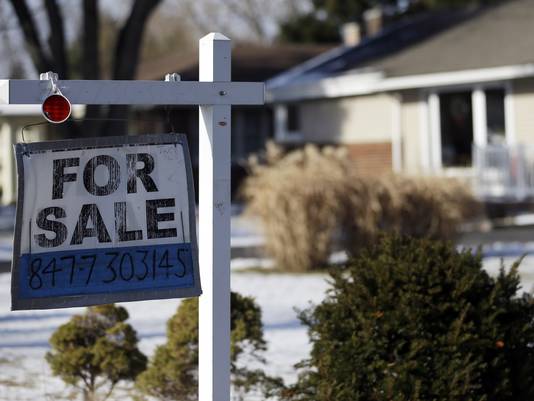
In this Jan. 5, 2013, photo a “for sale” sign is seen outside a home in Glenview, Ill. Average U.S. rates on fixed mortgages rose this week but remained near record lows, keeping home buying more affordable. (Photo: Nam Y. Huh AP)
Story Highlights
- Home prices in the 20-city index slid 0.1% in November from October
- Only NY shows year-over-year drop
- Low supply contributes to higher prices
Home prices rose 5.5% in the 12 months through November, providing more evidence of a recovering housing market, a closely-followed report showed Tuesday.
The Standard & Poor’s Case-Shiller index of 20 major cities showed prices rising in 19 of the 20 cities for the 12-month period. Prices fell only in New York — by 1.2%.
Compared with October, the index showed a 0.1% decline.
“Housing is clearly recovering,” said David Blitzer, chairman of the home price index committee.
The November numbers were stronger than October with 10 cities posting gains month to month. Only seven cities showed monthly gains in October’s Case-Shiller report. Declines in 10 cities are not unexpected for November because of winter weather and normal seasonal slowdowns in housing markets.
In Phoenix, which has led the recovery, home prices posted the strongest monthly gain, up 1.4%. San Francisco also saw a 1.4% rise. Minneapolis followed with 1%. Chicago was among the weakest with a 1.3% drop in November from October.
The housing market helped pulled the economy into recession in 2007 but it has finally emerged as a bright spot in the economy. Prices are rising as are both new and existing home sales.
Case-Shiller’s data shows the Southwest — represented by Phoenix and Las Vegas — have the strongest home price gains while Southeastern cities Miami and Tampa are close behind. Year over year, Phoenix prices are up almost 23%.
California’s cities are also showing strong improvment but the Northeast and Midwest are lagging.
Other home price data also show increases for last year that came in higher than most economists expected.
Prices are being propelled by several factors.
In December, the nation’s supply of homes for sale fell to a 4.4 months, based on that month’s sales pace. That was the lowest level since May 2005, the National Association of Realtors says.
The supply situation, which has been tightening for six months, has led to multiple bids for houses in some markets.
“Any new listings are getting eaten up right away,” says EJ Bowlds, managing broker for Coldwell Banker Bain in Mercer Island, Wash. Multiple offers of 6 to 10 per home are now common, he says.
A slowly improving economy and low interest rates, which ticked up slightly to 3.42% the week ended Jan. 24, are also fueling demand.
Prices are expected to keep moving higher this year, many economists and market watchers say.
Prices will rise an average of 3.1% in 2013, according to the most recent survey of more than 100 economists and real estate experts surveyed by market watcher Zillow.
“We have probably hit bottom and we’ve probably come off the bottom a little,” says Lawrence White, economist at New York University Leonard N. Stern School of Business.
